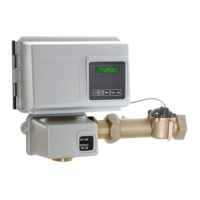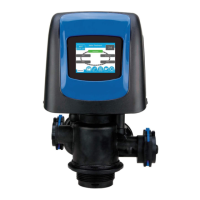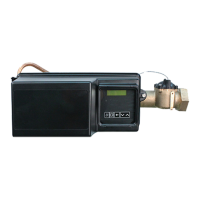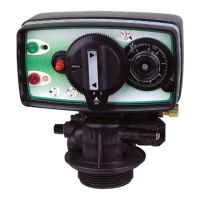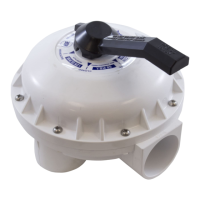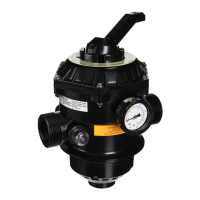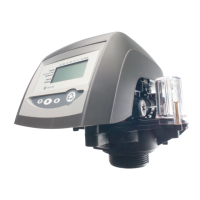FLECK 2850 Control Valve Service Manual • 5
Position
Meter Dome
at 12 o’clock
orientation
Meter
Union
Valve Body
Powerhead Assembly
START-UPINSTRUCTIONS
The water softener should be installed with the inlet, outlet, and
recommendations, and to meet applicable plumbing codes.
1. Turn the manual regeneraton knob slowly in a clockwise
direction until the program micro switch lifts on top of the
switch position changes, the valve will advance to the next
regeneration step. Always allow the motor to stop before
moving to the next set of pins or spaces.
NOTE: Forelectronicvalves,pleaserefertothemanual
regenerationpartofthetimeroperationsection.Ifthe
valvecamewithaseparateelectronictimerservice
manual,refertothetimeroperationsectionofthe
electronictimerservicemanual.
2.
remains steady for 10 minutes or until the water runs clear
(see above).
3. Position the valve to the brine / slow rinse position. Ensure the
unit is drawing water from the brine tank (this step may need
to be repeated).
4. Position the valve to the rapid rinse position. Check the drain
5.
Ensure water goes into the brine tank at the desired rate. The
6. Replace control box cover.
7. Put salt in the brine tank.
NOTE: Donotusegranulatedorrocksalt.
SYSTEM DISINFECTION
The system is not intended to be used for the treating water
that is microbiologically unsafe or of unknown quality without
adequate disinfection before or after the system.
DisinfectionofWaterSofteners
The materials of construction of the modern water softener
will not support bacterial growth, nor will these materials
contaminate a water supply. During normal use, a softener
may become fouled with organic matter, or in some cases with
bacteria from the water supply. This may result in an off-taste
or odor in the water.
Some softeners may need to be disinfected after installation
and some softeners will require periodic disinfection during
their normal life.
Depending upon the conditions of use, the style of softener,
the type of ion exchanger, and the disinfectant available, a
choice can be made among the following methods.
SodiumorCalciumHypochlorite
Application
These materials are satisfactory for use with polystyrene
resins, synthetic gel zeolite, greensand and bentonites.
5.25% Sodium Hypochlorite
These solutions are available under brand names of household
bleach. If stronger solutions are used, such as those sold for
commercial laundries, adjust the dosage accordingly.
1. Dosage
A.
foot.
B.
cubic foot.
2. Salt tank softeners
A. Backwash the softener and add the required amount
of hypochlorite solution to the well of the salt tank. The
salt tank should have water in it to permit the solution to
be carried into the softener.
B. Proceed with the normal recharge.
Calcium Hypochlorite
Calcium hypochlorite, 70% available chlorine, is available in
several forms including tablets and granules. These solid
materials may be used directly without dissolving before use.
1. Dosage
A. Two grains (approximately 0.1 ounce [3 ml]) per cubic
foot.
2. Salt tank softeners
A. Backwash the softener and add the required amount of
hypochlorite to the well of the salt tank. The salt tank
should have water in it to permit the chlorine solution to
be carried into the softener.
B. Proceed with the normal recharge.
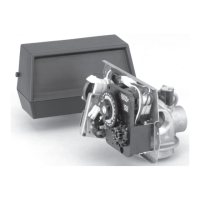
